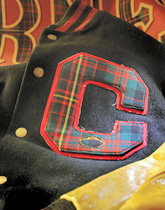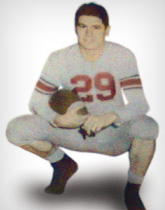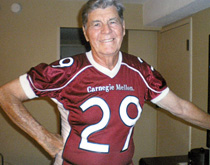
Tom Craig's jersey is soaked. Freezing rain is pouring down on the football field. And he's bleeding, ever since someone's stray elbow whacked him in the face on an early play. Even now, he can feel the dull throbbing where his split lip is scabbing over. Muddy and tired, Craig is concentrating on only one thing: the game.
He plays both sides of the field, defensive end and offensive end as his coach dictates. The weather and the wound are not enough to distract him from the most important factor: the win.

Craig has been in dozens and dozens of situations like this one. He's played on muddy football fields in freezing weather, and he's played in blaringly noisy basketball gyms, the echo of the opposing fans' chants ringing in his ears. Sports have been a part of his life since the age of 10, the year he lost a front tooth playing backyard pickup football.
As a collegiate athlete, he has been a winner, making the Carnegie Tech varsity basketball team in his freshman year and beating rivals such as the University of Pittsburgh and Penn State.
This year is his third at Carnegie Tech, but his first on the football team. The move to participate in two varsity sports did have a bit of suspense. By midday, during his first practice for the football team, Craig's basketball coach, Mel Cratsley, heard the "rumor" that his star basketball player was participating in another varsity sport. He stalked to the field, looking for some answers from Craig. "I just wanna play football, Coach," the student told him. As it turned out, Cratsley himself had played both basketball and football in college, so, in the end, he didn't try to dissuade his star player from competing on the gridiron.
Craig's innate desire to return to football, a sport he'd played in high school before a back injury put him in a cast for six weeks his senior year, led him onto that Washington and Jefferson College field in Washington, Pa., where he is fighting the weather, the injury, and the opponent. The combination doesn't thwart Craig or his teammates. The Tartans win the game.
By Craig's junior year, he had established himself as an athlete and a good student. During his freshman year, calculus looked like it was going to defeat him. But he wouldn't let that happen. "That summer, I worked in the steel mill, but I also repeated my second-semester calculus ... It took me the first two weeks, and then, 'Bingo,' I caught the whole concept of what calculus was about," he says.
It helped lead to another revelation. Although he had an athletic scholarship for basketball, it dawned on him that he was really at college to learn: "I transitioned myself to be darn good in sports and school, too."
He ended up playing three varsity sports: football, basketball, and golf. He didn't just play sports, he was a star—the four-year basketball standout tallied 1,130 points in his career and graduated as the university's all-time leading scorer and first to score more than 1,000 points. In football, he was selected as a Collier's Magazine first-team small-college All-American in 1952 and was Carnegie Tech's Varsity Athlete of the Year in 1953. Just as important, he says, he made the Dean's List his senior year.

More than five decades have passed since he earned his engineering degree in 1953. With the passing of time and the way the world has changed, he believes that the college athletes at Carnegie Mellon today deserve the highest of accolades. "I'm proud of them," he says. "They're really good students, really good athletes."
What is most impressive to Craig is that they don't get the benefit of athletic scholarships like he did, but they play anyway. Out of his respect for the players of today, the longtime donor to Carnegie Mellon wanted to make sure that they are recognized for their achievements on and off the field. "I said to myself, 'So much of me belongs to the athletic side of the university. I think the athletic side of my career at Carnegie rounded out my personality and made me the person I am today.' I wanted to do something specifically for that side."
After conversations with Carnegie Mellon Athletic Director Susan Bassett about how to best honor student athletes, Craig and his wife, LaVerne, made a $30,000 lead gift to start an endowment fund for the Carnegie Mellon Athletics Awards Banquet. At the annual banquet, held each spring, student-athletes are honored by the administration and their head coaches. The seniors and four-year letter winners are recognized, and a total of 19 Tartan Awards are given to the leaders of the respective sports. Two of the Tartan Awards, in basketball and football, are now named after Tom Craig. He spoke at last year's affair.
"When each of us look at what we learn from sports outside of a classroom, you find characteristics such as teamwork, toughness, courage, sportsmanship, humility, patience, and integrity, to name just a few. That's why playing sports and being an athlete makes each of us a better person."
Craig, still a competitor, has challenged his alumni athletes: "We have a goal to reach now, there are 14 more Tartan Awards waiting to be named," he says.
Michelle Bova (HS'07) is a freelance writer and has been a regular contributor to this magazine since her senior year.



